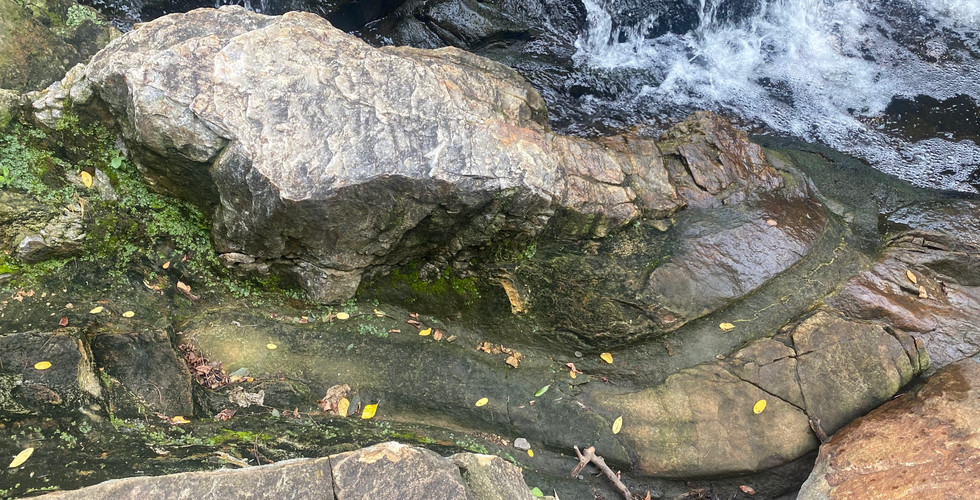There’s a wealth of geological history in the Stony Run
- Friends of Stony Run
- Dec 20, 2024
- 3 min read
by Carl R. Gold
Editor's note: This commentary originally appeared in the Baltimore Sun.
Tired of getting stuck in traffic jams as you try to “go down the ocean, hon?” Not a fan of crowded beaches and hot sand? Afraid to drive across the Bay Bridge? You can visit the ocean without leaving Baltimore and at the same time, see evidence of our kinship with Europe.
Stony Run, a tributary stream of Jones Falls, runs along the fall line separating the Atlantic Coastal Plane and the Piedmont Plateau. Its bed consists of various crystalline rocks, including Carroll Gneiss, a metavolcanic rock that was erupted (meaning it formed when magma solidified and crystalized on the Earth’s surface) in an oceanic environment during the early Ordovician Period, some 470 million years ago. Six-hundred to 400 hundred million years ago, before it became the stream bed, the Carroll Gneiss and the rocks of the surrounding area, including large parts of northern and western Baltimore City, were beneath the Iapetus Ocean.
During its existence, the Iapetus Ocean covered much of the southern hemisphere. It was formed after the giant land mass known as Rodinia finally broke up 600 million years ago and it is the precursor of the Atlantic Ocean as we now know it. In Greek mythology, Atlantis is the son of Iapetus – hence the Atlantic Ocean taking the place of the Iapetus Ocean.
Granted, as you walk in the creek, or as some prefer, “go crickin,” as the cold-water chills your toes, you will not be lured by the siren like smells of Thrasher’s french fries, suntan lotion, or Old Bay wafting from boardwalk crab feasts, but you will see evidence of humanities common bond.
In an example of geologic time laughing at puny humans, immediately adjacent to the Gneiss at Stony Run is pegmatite, an intrusive (meaning it solidified and crystalized beneath the earth’s surface) igneous rock formed during one of the land masses mountain building phases. Pegmatite is made up of entwined feldspar and quartz crystals.
Stony Run, with its headwaters in North Baltimore, is one of several worldwide spots under study at Johns Hopkins University, proving the interconnection of North America with Norway, Scotland, and Ireland. Samples of the same ocean underlying rock are found in all three places. Geologists date specimens from each location to track the tectonic processes that played out in this long-gone setting. This research provides support for the theory that these areas were connected during the second, or Pangea, supercontinent era.

On a beautiful Sunday morning in June, two dozen fortunate folks received a boots on the ground and hands on the rocks geology lesson sponsored by The Friends of Stony Run. Our instructors included Johns Hopkins University Professor Daniel Viete, Martin F. Schmidt, author of Maryland’s Geology, and James Wolf, President, Friends of Stony Run. With their guidance we could see where tectonic plate collisions caused rocks to fold over themselves- the hinges of these folds were clearly visible and visceral. The hinges and folds were – pun intended- rock solid but the nearby pegmatite crumbled in our hands with little effort. Though the Iapetus Ocean died, due to a process called subduction (when dense, oceanic crust sinks back into the earth’s mantle), some pieces were thrust up and preserved for study for experts and amateurs alike.
Subduction ultimately kills all oceans. Fortunately for us, this occurs on a geologic time scale of millions of years so there is still plenty of time to go to Ocean City if you would rather feel the sand on your feet than the cool waters of Stony Run. As you do, however, remember from whence we came. Humanity has had a greatly accelerated impact on Earth; we operate at warp speed compared to plate tectonics. We use resources that took millions of years to accumulate at a pace that can never be replenished as it does not allow the natural system to keep up. Homo sapiens have only been around for about 300,000 years – a few grains of sand in the hourglass of time.
Carl R. Gold is a Maryland Master Naturalist, cgold@carlgoldlaw.com , Instagram and X @crgkoko









